[ad_1]
It’s the 80/20 rule of content marketing: 80% of results come from 20% of your content. This is true for every website and for every content audit I’ve ever done. A small handful of articles pull in a big percentage of traffic and conversions.
Just look at your own data. A report of your top posts by traffic probably looks something like this. A few posts bring in a lot of traffic, while most articles drive little or no traffic.
If you calculate the conversion rate for each piece of content, you’ll see a similar curve. A few articles convert visitors at a high rate, while most articles convert few or no visitors.
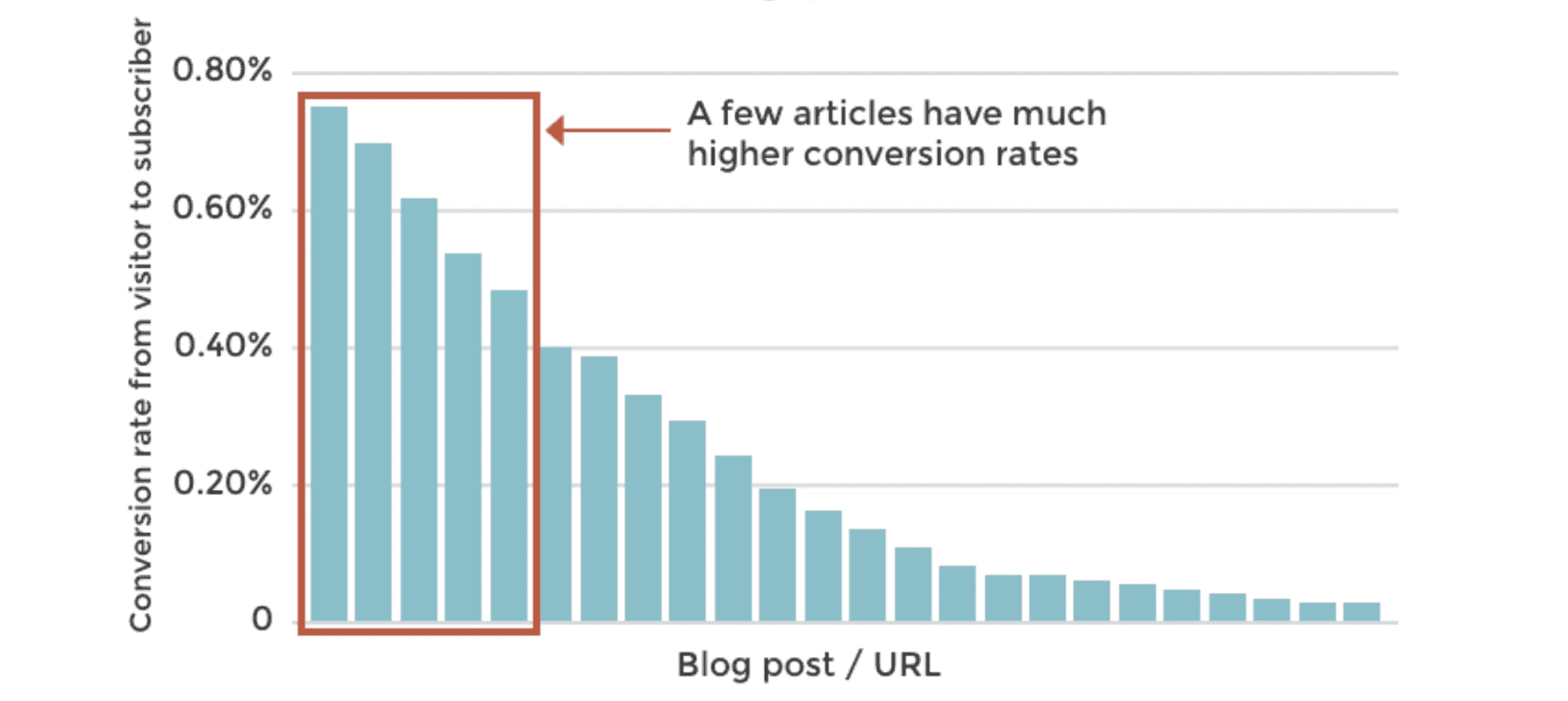
A content audit for finding the top performers
If it’s true that 20% of articles create 80% of the results, we should focus more on these top performers. We need to find them, analyze them and try to replicate the results.
The problem is that usually, we don’t know which articles are the real heroes. To find out, we need to do a content marketing audit.
Today we’ll do it with the latest version of Google Analytics and do a content marketing audit using GA4, which you should have added as a tag to Google Tag Manager. We’ll also use a bit of Google Search Console.
We’ll focus on the top three promotion channels: SEO, email marketing and social media. Once you’re done, you’ll know what works where.
- Top performing traffic sources
- SEO: Content that attracts visitors from search
- SEO: Content with rising or falling search traffic
- SEO: Keyword performance for any article
- SEO: Content that has search ranking potential
- Email: Top performing email campaigns
- Social: Top performing social networks
- Social: Content that gets the most traffic and engagement from social media
- Where did this article perform the best?
At the end of each section, we’ve added next steps and action items, with suggestions for what to do with the data to drive better content marketing outcomes.
1. Which are our top performing traffic sources?
It’s a fundamental marketing question. Some content strategies focus on social media. Others publish evergreen, keyword-focused content for SEO. Most content programs promote content everywhere, but content performance varies widely across channels.
We’ll start with an easy one. Here’s how to check and see, at a high level, where your content is performing best.
- From the Reports section, go to Acquisition > Traffic acquisition
- Click on the pencil icon in the top right to “Customize report” (you’ll need to be logged in using an account with more than just “Viewer” level access)
- Now click “Metrics” to select some useful metrics. We recommend the following:
-
- Users
- Sessions
- Engagement rate
- Average engagement time per session
- Bounce rate (less meaningful than engagement rate, but some people still like it)
- Session conversion rate
Bounce rate and session conversion rate won’t be on the list. You’ll need to add them by clicking the “Add metric” dropdown at the bottom of the list, then searching for them.
Reorder the metrics if you’d like. Here’s what the customization will look like:
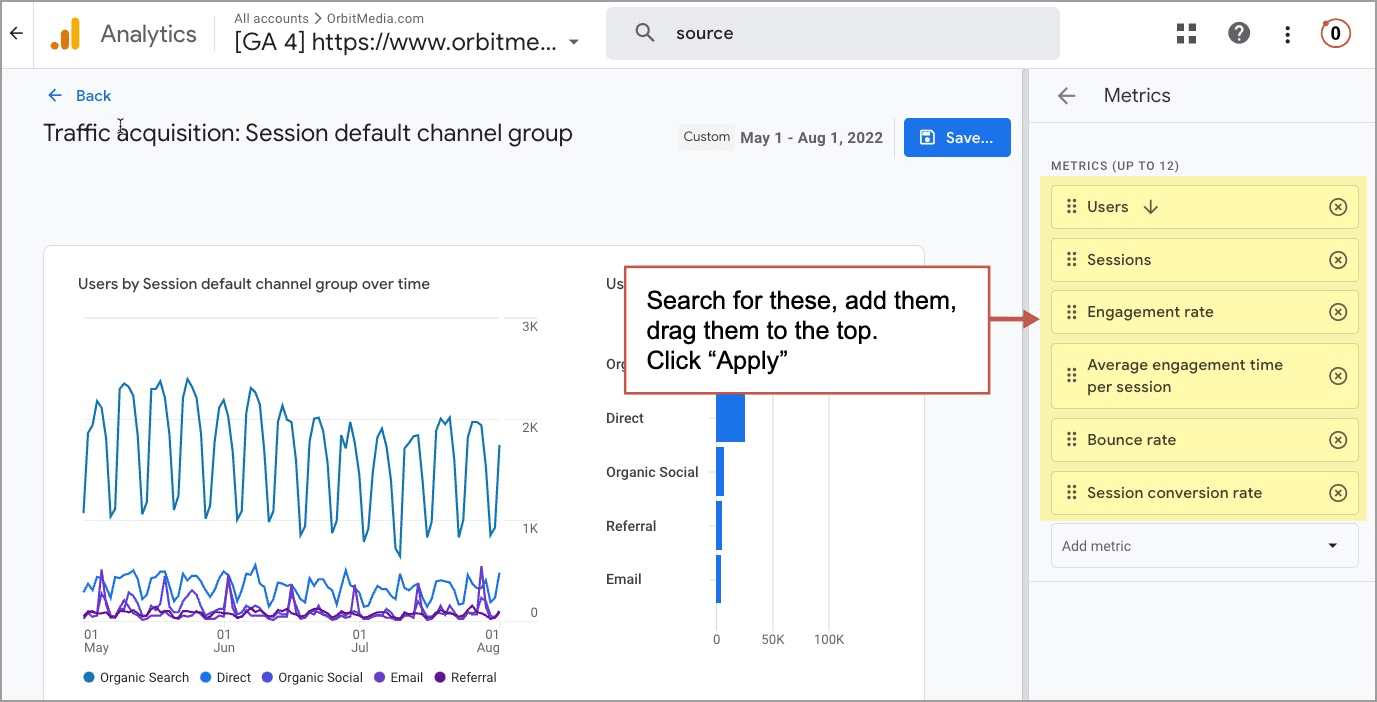
- Save the customization. You’ll be given the option to “Save changes to current report” or “Save as new report.” It really makes no difference. I always just save the changes to the current report. Explorations, not reports, are usually worth saving for keeps.
- Select a conversion from the dropdown under “Session conversion rate.” Because we’re doing a content marketing audit, use a content-related goal, such as download or subscribe. Of course, you’ll need to have conversion events set up in GA4 or nothing will appear in that dropdown.
Now you’re looking at the performance of each “default channel group” which are the high-level sources of traffic. Comparing the metrics for each, you’ll see which are most effective in which ways.
You’ll immediately notice that some channels are better for attracting visitors. Others are better for engaging and converting visitors. If you’re looking for a benchmark engagement rate, our research found that 55% engagement rate is average across channels.
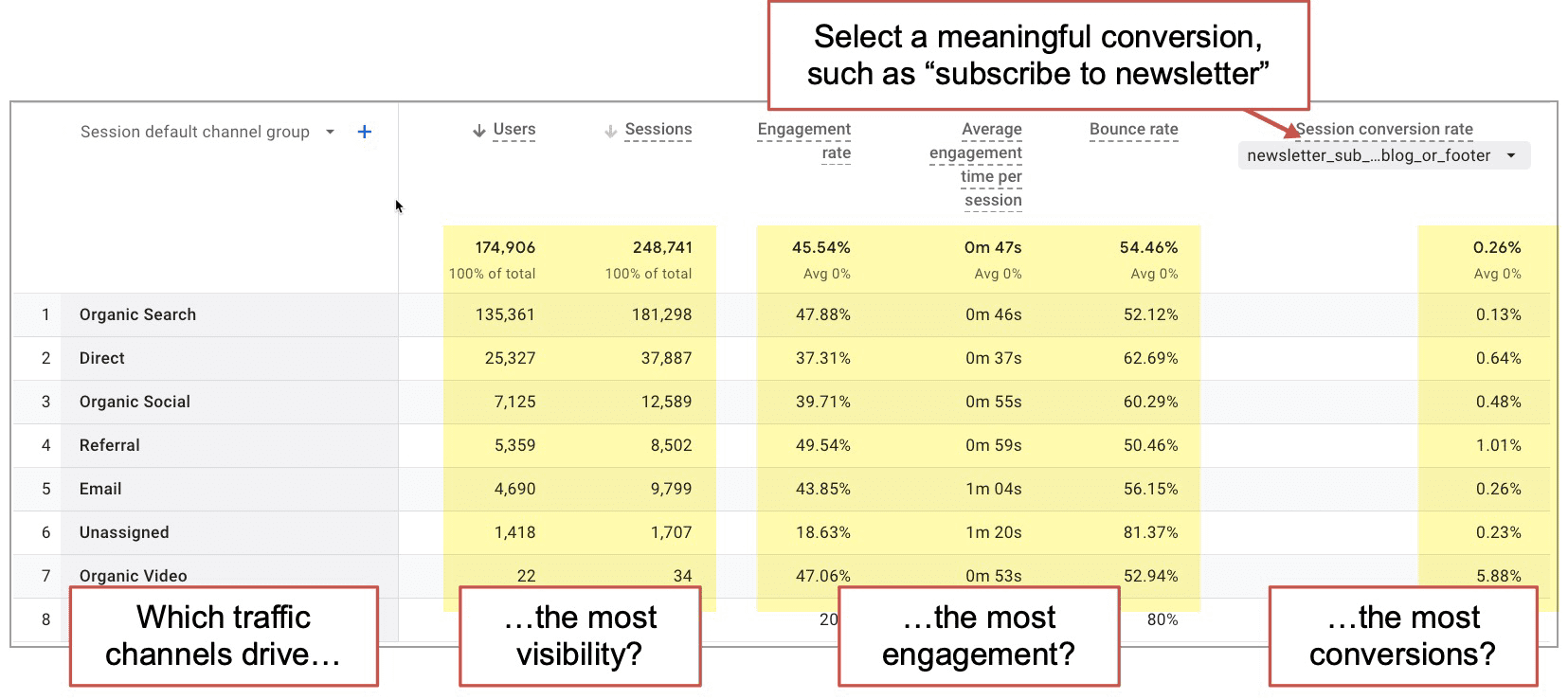
Next steps/Action items:
This kind of top-line data isn’t the best for making decisions. Are email visitors engaged? How are those Google Ads doing? We’ll do deeper analysis in a minute.
But the big picture content strategy impact is usually something like this:
- If it’s not working, fix it or give up on it.
- If it is working, double down.
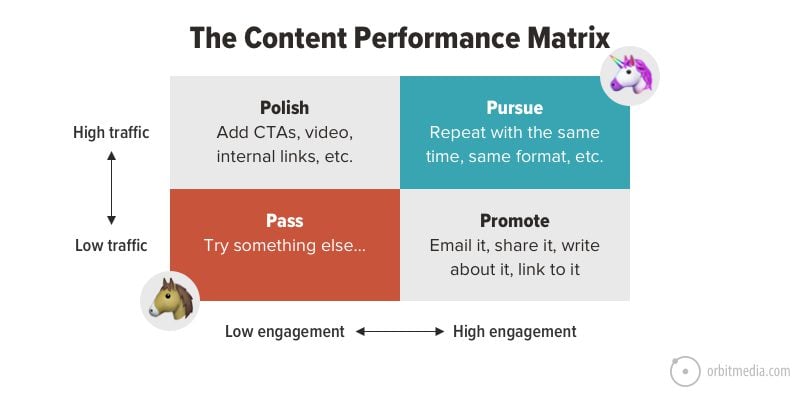
Source: Content Performance Matrix
Now let’s analyze our content and its performance in the three main promotion channels, search, social and email.
2. SEO: Which content is attracting visitors from search engines?
Some pages have durable visibility. People search, the page ranks, people click and the page gets a steady stream of traffic. This traffic is often stable for months and years. Content marketers, like SEOs, should have these on their radar.
The good news is that your top performers are easy to find. Here’s how to use GA4 to find your top pages for organic search performance:
- Go to Reports > Engagement > Pages and screens: Page title and screen class. We’re looking for content so we’ll start here.
- Above the first column in the data table, there’s a drop down for setting the primary dimension. It has only a few options. Use “Page path and screen class” which is basically the URL.
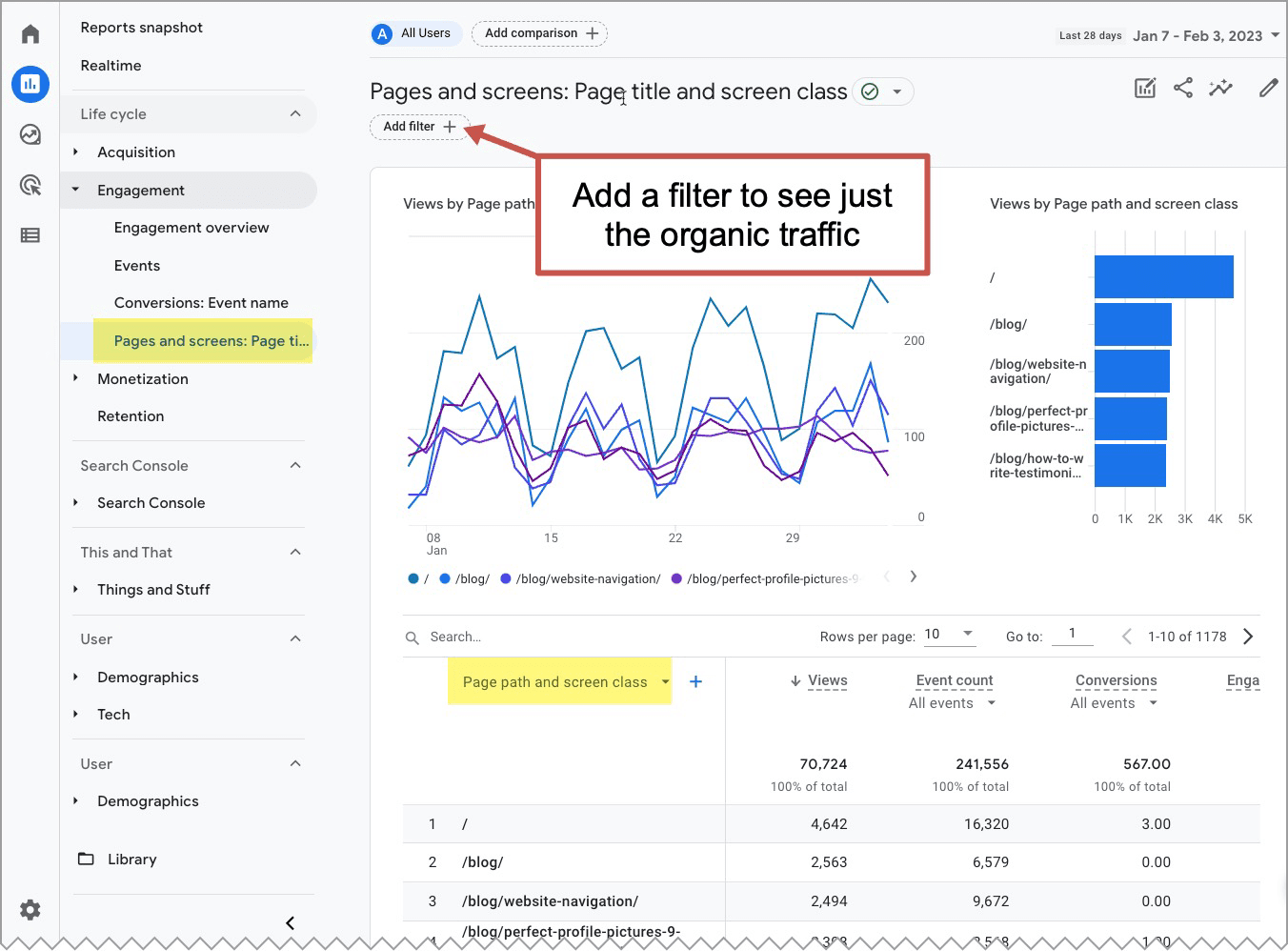
- Next we’ll add a filter, so we’re just looking at Organic traffic. Click “Add filter” above the line chart. The “Build filter” options will slide out from the right. Just like filters in Universal Analytics, the GA4 filters allow you to include or exclude any value from any dimension.Here we want to include the “Session medium” dimension. The value we want to include will appear in the dropdown of dimension values below. Check the box for “organic” and click ok.
- Click “Apply” in the bottom right corner to apply the filter to your report.
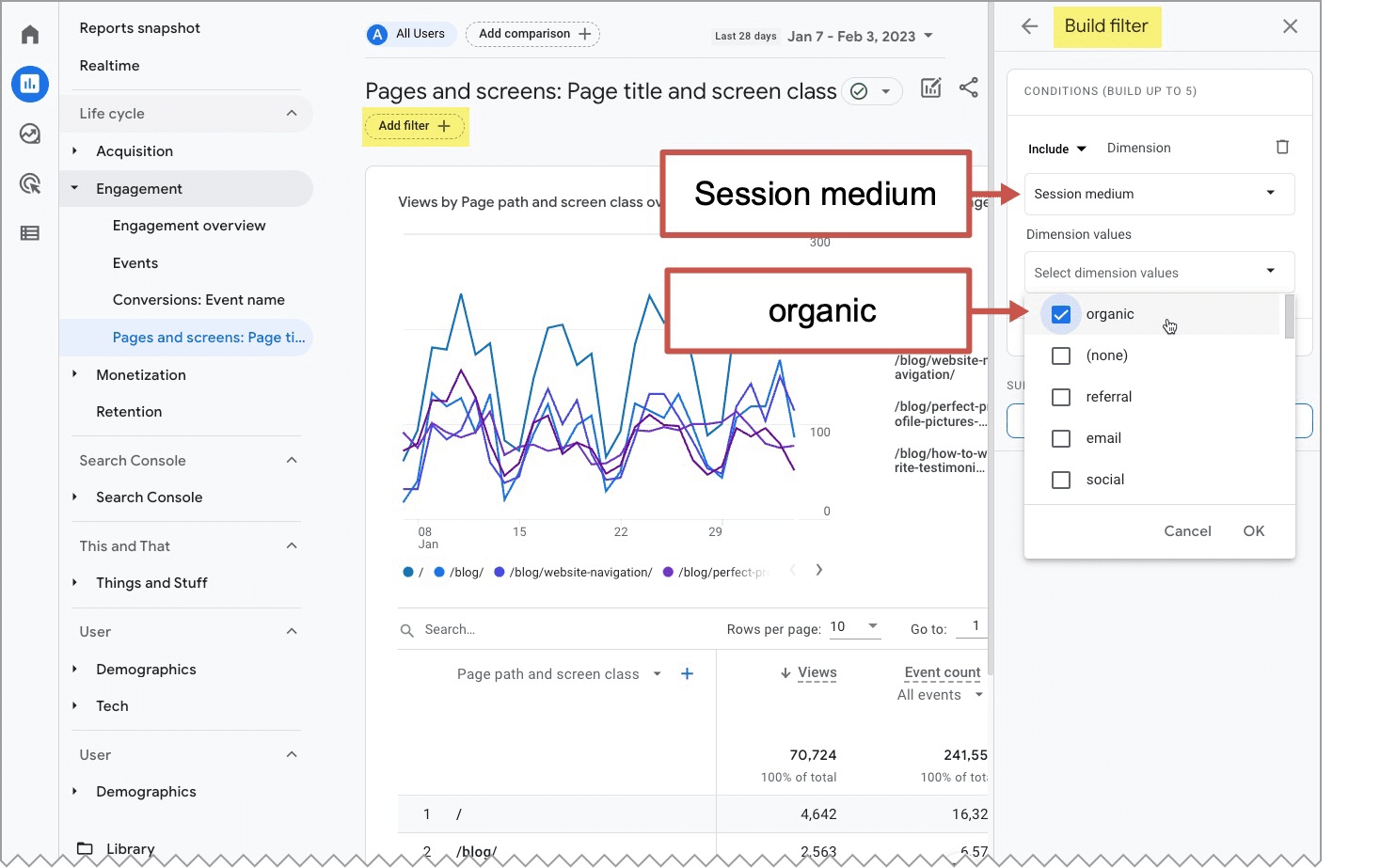
- If your blog content is all within a directory (such as website.com/blog) it’s easy to filter this report to show only blog posts. Just type “blog” into the search tool above the first column to view just your content marketing URLs. It’s very convenient and one of several reasons to keep your blog in its own directory.
This report is showing all traffic to your blog post from any visit from search, whether it was the first page they visited or the tenth. But we really want to know the performance of these URLs when they were the landing page, as in the first page of the session.
- So the final step is to click on the little dropdown under “Event count” and select “session_start.” This event is triggered when the session begins. So adding it here turns this report into a landing page report.

Now you’re looking at a list of all of your top performing articles from search. This is an SEO report and these are your winners.
Next steps/Action items:
Many of these will have 10x the visibility of your other pages. So there’s a lot we can learn from them.
- Make more of them
What do these articles have in common? Are they more detailed? Focused on a more specific topic? Are they linked to a lot from other articles? Analyze then emulate. - Add CTAs to them
These have high-levels of durable visibility (your best cheese). Add internal links and calls to action from these articles to your highest converting articles (your best mousetraps). - Exclude them from other reports
Some of these outliers produce such huge results they create noise in other reports. If they’re irritating, don’t delete them. That would have a cost with no benefit. Just exclude them from Analytics by creating a filter in any report.
3. SEO: Traffic from organic search is rising/falling for which articles?
This is your early warning system. If you’re paying attention to changes in organic traffic for specific articles, you can take action before something falls into the abyss. This way you can defend your total topline traffic.
You also won’t be surprised when overall organic traffic falls if you’ve been watching that one random, super high-traffic post start to drop in rankings.
To track the changes in search traffic to specific URLs, simply add a comparison to the date range.
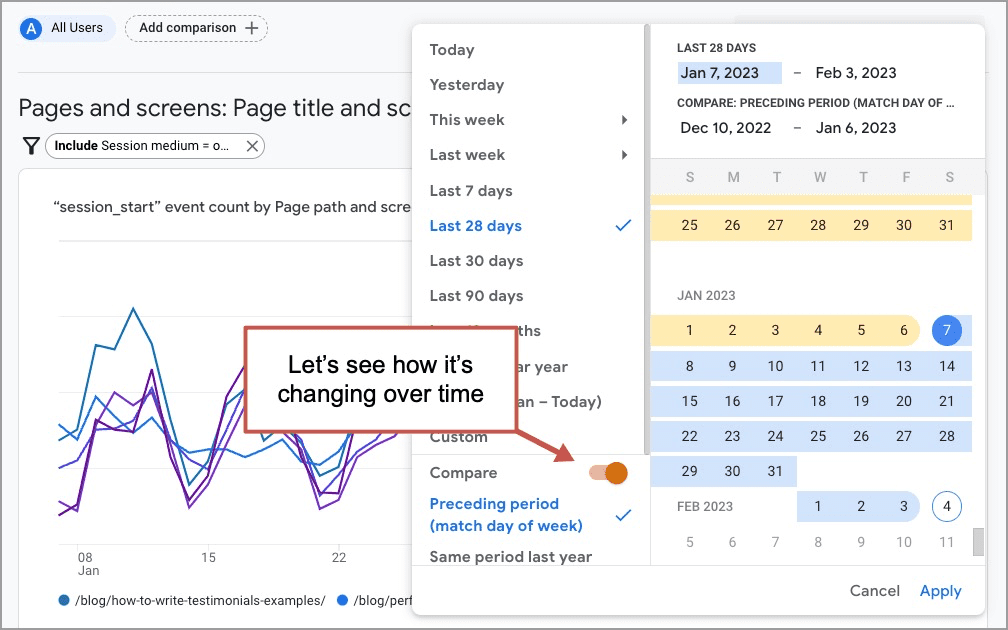
Now the same report shows organic traffic rising or falling. Scanning through, you’ll immediately see which ones need a little love.
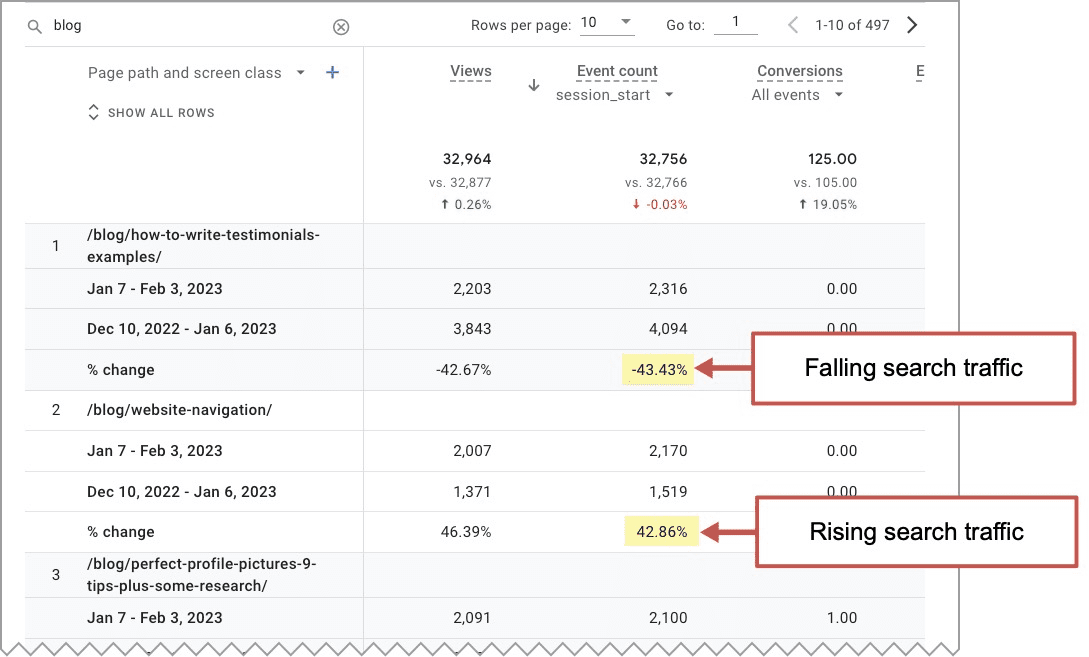
This is more useful than tracking rankings for specific phrases. Rank tracking is nice, but what if it’s a low-performing keyphrase? Or what if that page ranks for other, more popular phrases? If so, tracking specific rankings can be misleading.
Many SEOs are too focused on rankings and not focused enough on actual organic traffic. SEO is not really about rankings. SEO is about traffic.
Next steps/Action items:
Pages that have rising search traffic don’t need help. But take a look at them anyway. A lot of other people are. Make sure everything is up-to-date and looking good. It’s like tidying up a room that a lot of guests are visiting.
Pages that have declining search traffic do need help.
The best way to reverse the ranking slide is to improve the quality of the page. That can mean a lot of things.
- Add visuals (graphics, video)
- Add contributor quotes (from subject matter experts)
- Add supportive evidence (charts, examples)
- Add formatting (subheads, bullets, numbered lists)
But there is one specific change that is most likely to improve the declining search rankings. It’s all about content quality and relevance.
- Add depth and detail that includes semantically-related phrases.
It doesn’t help to cram the target phrase in more times. It does help to add content that answers related questions, touches on the subtopics, and goes deeper into the material. Make it a better page. This is the key to SEO.
One great way to improve the relevance of a page is to confirm that it incorporates all of the phrases it’s already ranking for. So let’s go find them…
4. SEO: What phrases is this page ranking for?
For this part of our content marketing audit, we’ll go beyond GA4 and into GSC (Google Search Console).
There are lots of SEO tools that will show you the rankings of a specific URL, but the primary source is Google itself. Google Search Console doesn’t track changes to rankings for specific phrases, but it shows the “average position” for any phrase for any page over any time period.
Here’s how to use Google Search Console to check the rankings of any page on your website.
From the Search results report:
- Select a recent date range
- Select the “PAGES” tab
- Click on the filter icon and then enter the URL (or a word from the URL) to find the page.
- Click on the URL to see just that page
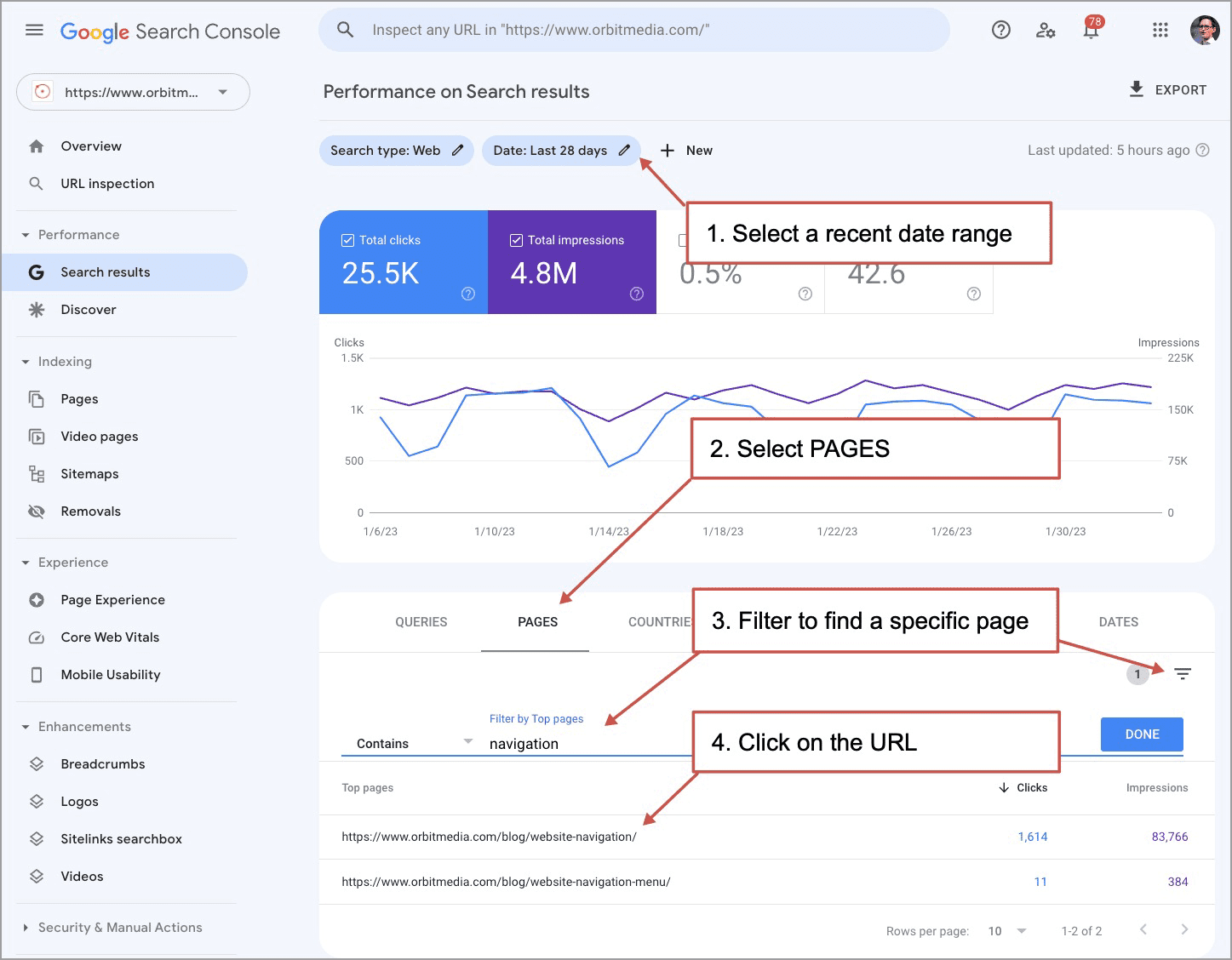
Now you’re looking at the search performance for that specific URL.
- Check the “Average position” box to add that data to the report
- Click on the “QUERIES” tab
Now you’re looking at the keyphrases for which that URL ranks.
- Sort by “Position” and scroll down past the top rankings
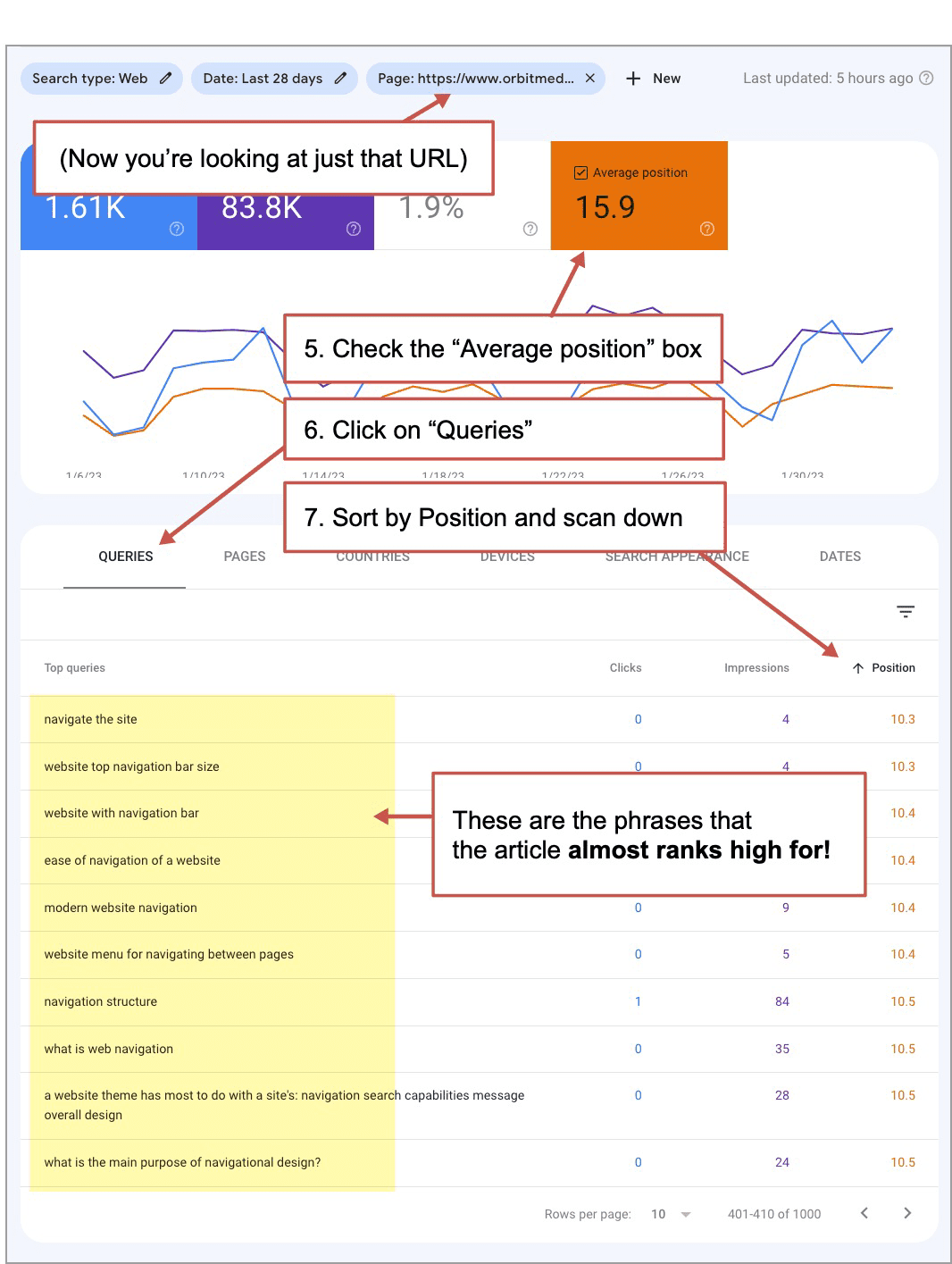
Next steps/Action items:
Knowing keyphrase performance is part of a content marketing audit, but it’s also useful for finding semantically related phrases. Then you can make SEO-focused edits to those almost-high-ranking articles.
- Improving the relevance for the top queries, by updating an article, adding these specific phrases.
- Confirm that the top performing phrase is, in fact, the primary target keyphrase of the article. If not, consider refocusing the article on that top performing phrase and include it in the title tag and <h1> header.
The outcome of these actions isn’t just higher rankings for top phrases. It’s also about ranking for an even greater number of phrases. This is the point of semantic SEO.
5. SEO: Which pages have ranking potential?
It’s possible that you’ve published articles that have been linked to from other websites but don’t rank for much of anything. These are pages with high authority but low relevance.
These are the two main search ranking factors: authority (links from other websites) and relevance (content and keywords).
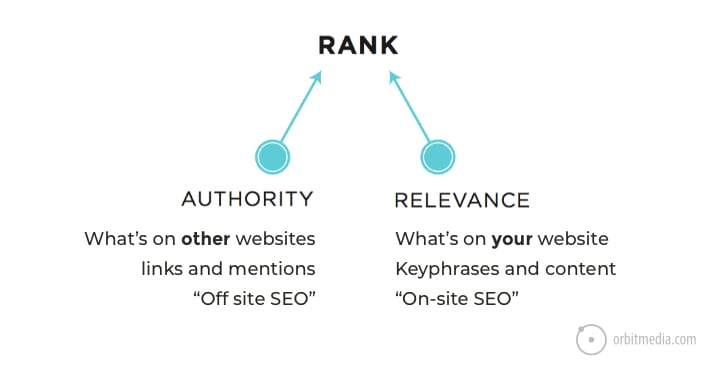
A URL with authority but low relevance has good ranking potential. It’s like a sports car parked in the driveway, waiting to be taken out on the open road. All it needs is better keyword focus.
To find which of your URLs has strong ranking potential, we’ll use Google Search Console. It will show you the number of websites (quantity) that have linked to any of your articles.
Really, the paid SEO tools are better for this because they show both the number of websites (quantify), but also the authority of each of those websites (quality), which is a key ingredient in the authority of your pages. A link from MySpace and a link from the New York Times aren’t the same. See our complete guide on keyphrase research for details.
But for this audit, we’ll stick with the free tool, Google Search Console.
- Go to the Links report
- Under External links, click on “More”
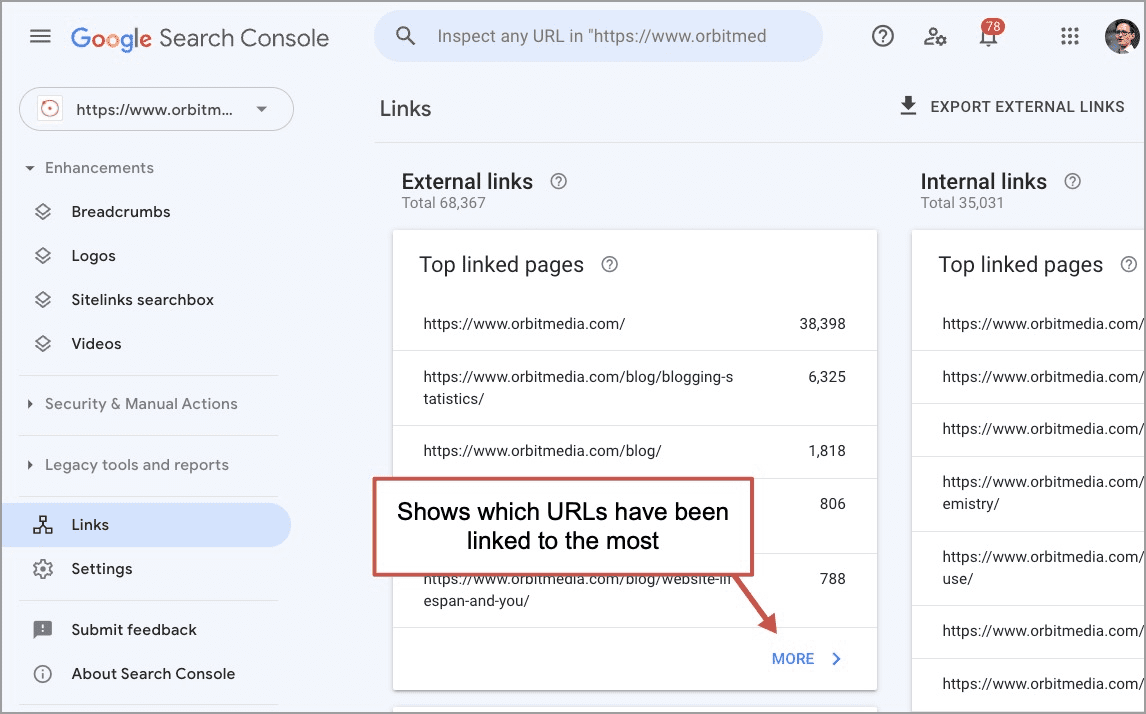
- To see just your content marketing articles, click on the filter icon, then enter “blog” or the name of the directory in which your articles are posted.
- Sort by linking sites.
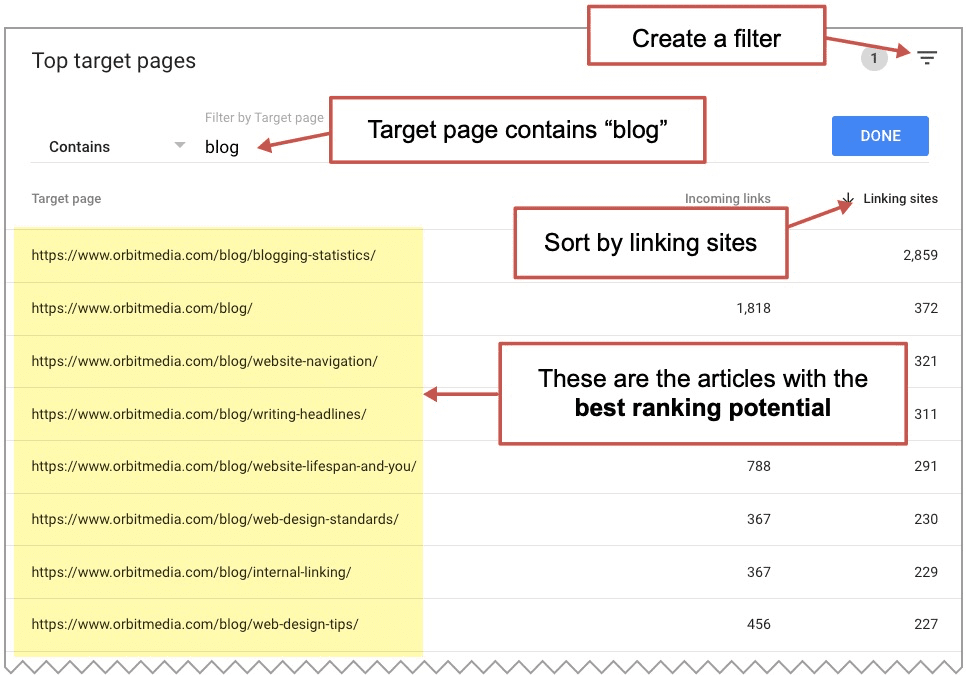
Next steps/Action items:
The idea is to prioritize these URLs while doing SEO. First, check the current rankings for these URLs
- If it already ranks for something, sharpen the focus on those target phrases.
- If it doesn’t rank for much, recycle that URL by rewriting the article completely, giving it a new keyphrase focus.
Updating existing content, rather than writing new content, is a faster path to greater visibility. See our guide on SEO-driven content updates for specific instructions.
Note: The page you are reading now is an example of this approach. This URL was originally published in 2017 and was about Universal Analytics. It’s been updated with a revised article for doing a content audit using GA4. By reusing this old URL, we’ve improved the relevance while preserving the authority.
6. Email Marketing: Which of our email campaigns have performed the best?
Moving on from SEO to email marketing. Now we’ll find out which of our email campaigns performed the best.
The beauty of Google Analytics is that it goes beyond the standard email metrics. Your email service provider (ESP) will show you pre-click metrics (deliverability, open rates, clickthrough rates). But you’ll need to add campaign tracking code to those links and buttons to see post-click metrics (traffic, engagement, conversion rates).

If you haven’t been adding campaign tracking code to your emails, today is a new day for your marketing! Start using this URL builder to append those magical campaign parameters (medium, source and campaign name) to every link and button to your website in every email. Here’s how.
Now you’ll be able to see the behavior of the visitors that come to your website from your email campaigns. Here’s the step-by-step process:
- Use a nice long date range so you can compare the performance of many campaigns.
- From the Acquisition > Traffic acquisition report, click on the pencil icon in the top right to customize the report.
- Click on the Metrics dropdown to select your metrics
- Select Sessions, Engagement Rate, Average engagement time per session and Conversions …or whichever metrics you like best. You can drag these to the top of the list for easy analysis. If you don’t see the metric you want, click the “Add metric” and search for it, then select it.
- Click Apply
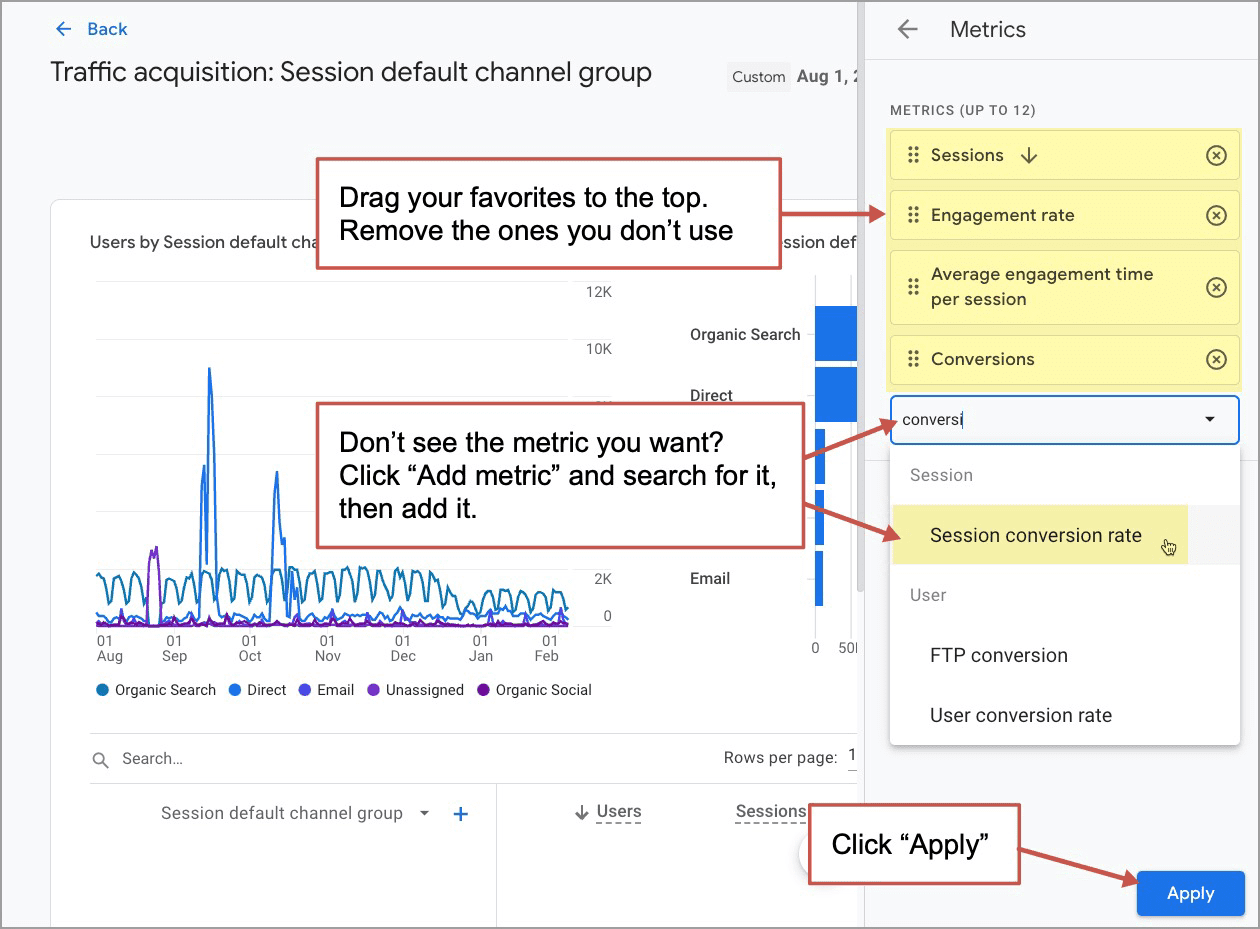
- Save the customization. Again, you can “Save to the current report” then click “BACK” in the top left to get back to the actual report.
- Next, we’ll need to add a filter to look at just the email campaigns. Click on the “Add filter +” button
- Select “Session medium” as the dimension.
- From the Dimension values drop down, select “email”
- Click “Apply”
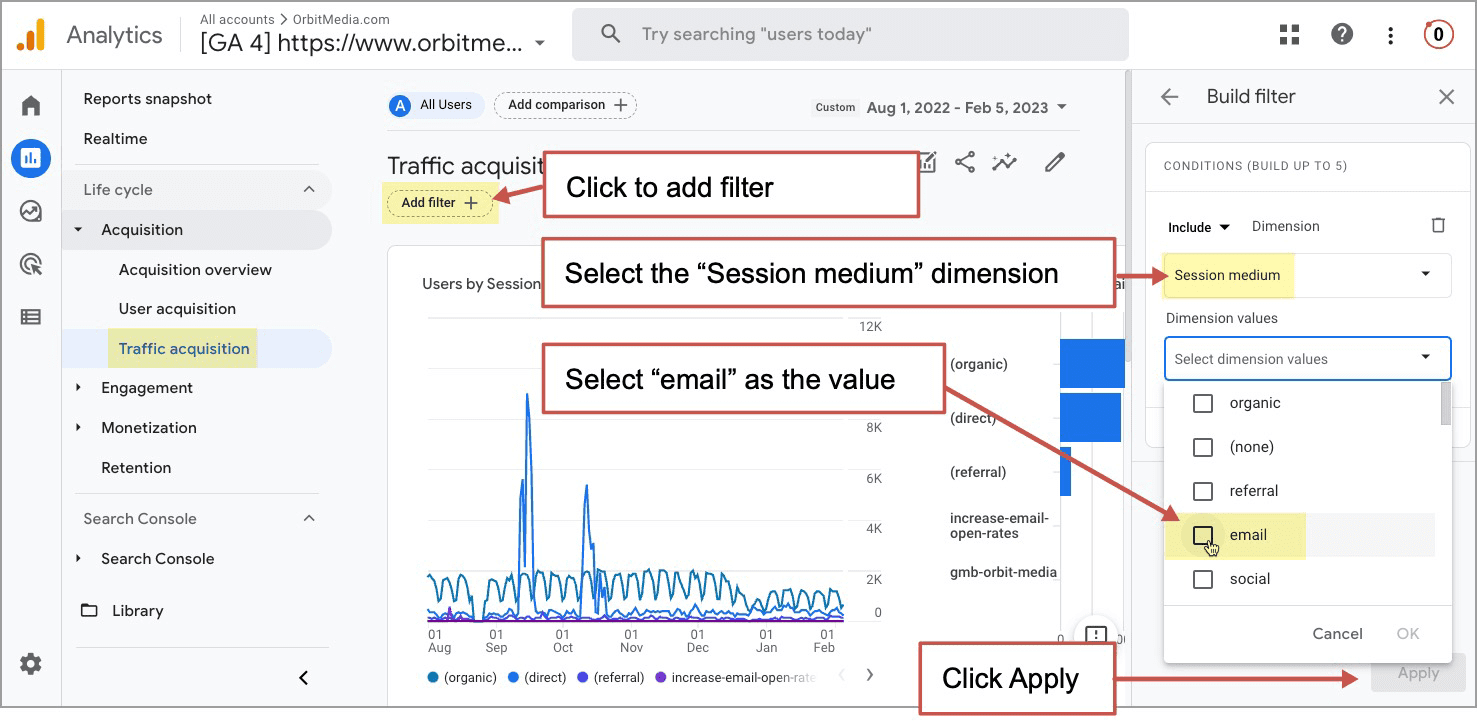
- Last step! In the dropdown above the first column, change the primary dimension from “Default channel group” to “Session campaign.”
Now you’re looking at the performance of every email campaign within that date range, as long as you added campaign tracking code. This report will show all campaigns, not just email, so you may need to sift through other data. And it shows all emails, not just content marketing emails.
You’ll quickly see that there is a wide variance in the performance of campaigns in terms of both traffic and conversion rates.
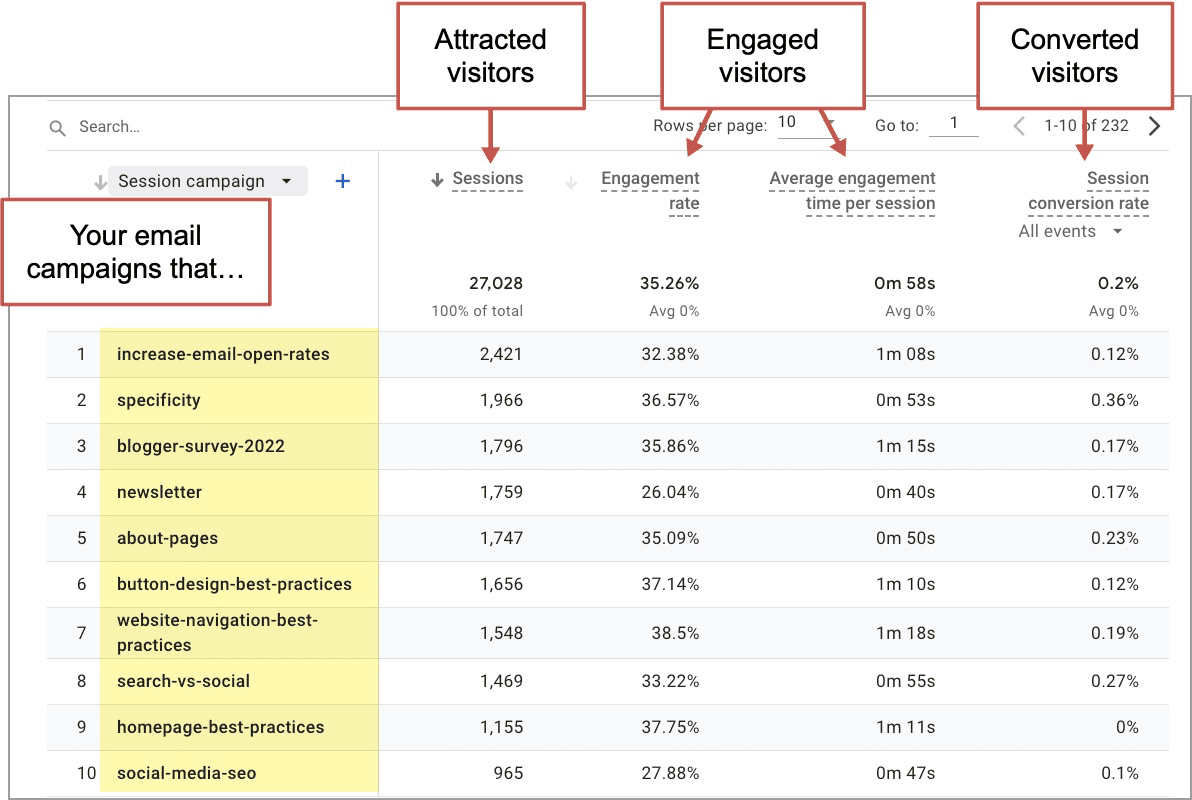
Next steps/Action items:
Look closely at the top performing campaigns. Review every element including the topics, timing, subject lines, creative, teaser text and calls to action. What do these outliers have in common?
- Repeat the results by emulating these top performers.
- Simply resend the top performers with new subject lines.
7. Social Media: Which social networks are performing the best for your content?
Moving on to social media marketing!
First, let’s audit the performance of the social networks themselves. Our topics and formats won’t perform the same with users across different social platforms. Some social networks will be more effective than others.
To audit the performance of various social networks, follow these steps. We’re using the same report customizations we used above, so we’ll have those same metrics: users, sessions, engagement rate, conversion rates, etc.
- Go to the Acquisition > Traffic acquisition report
- Click “Add filter +” so we can limit the data to just social media traffic
- Select “First user default channel group” as the dimension
- Click “Select dimension values” and check the “Organic Social” box
- Click “Apply”
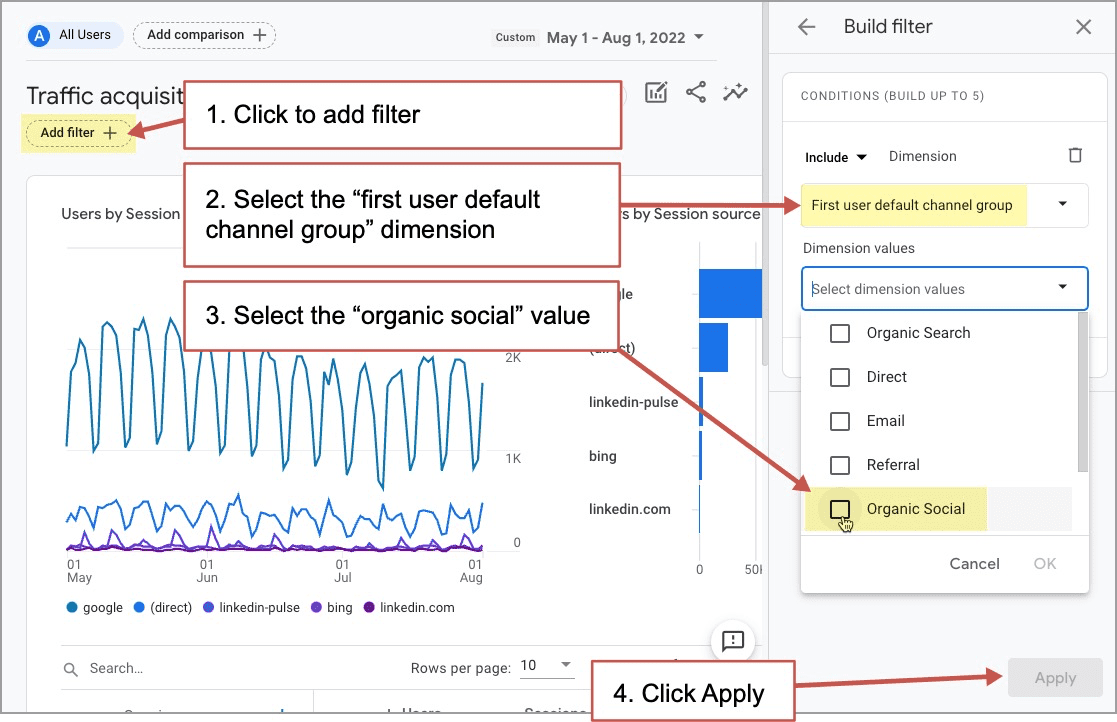
- Using the drop down above the first column, change the primary dimension from “Session default channel group” to “Session source”
Now you’re looking at the relative performance of every social network that has sent traffic to your website. You may see redundant things (several rows for the same network) and strange things (misattributed campaigns) but sift through the noise.
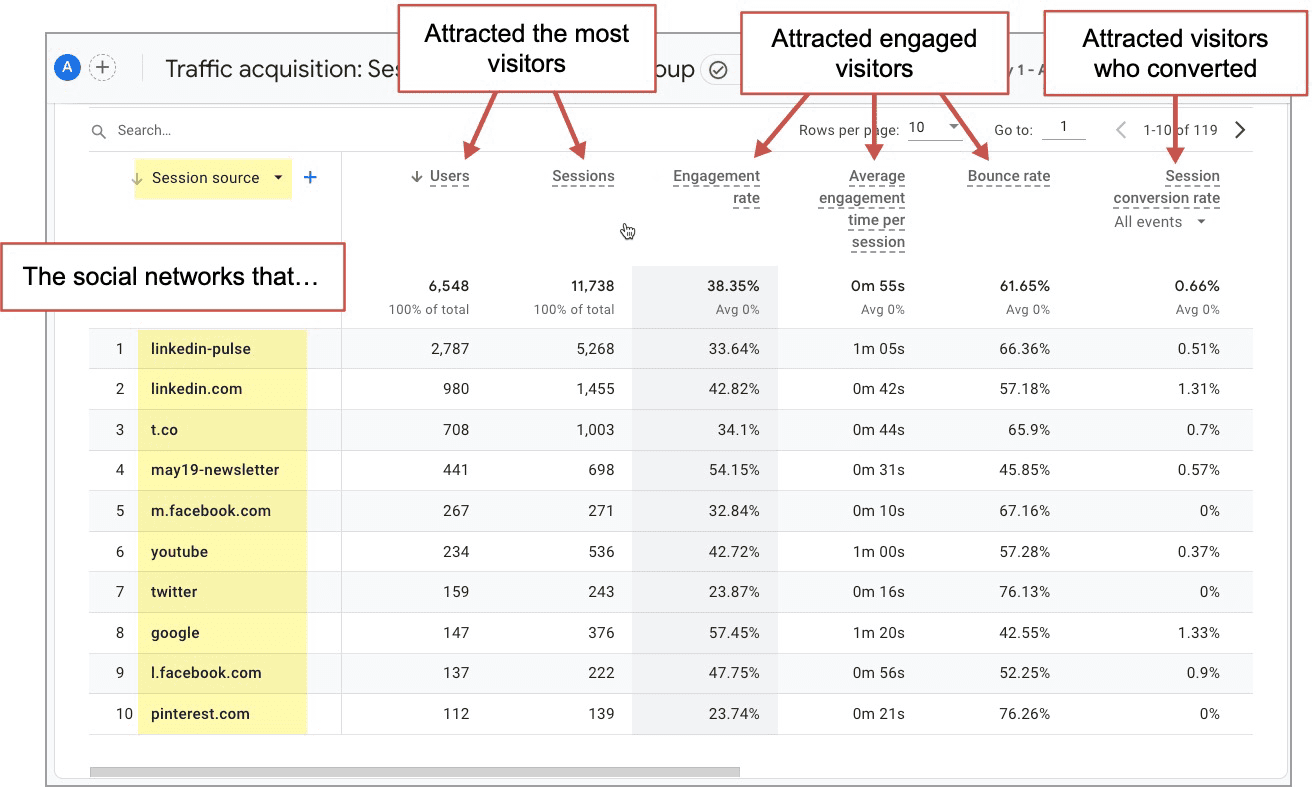
In the report above, you can see that traffic from LinkedIn is roughly twice as likely to convert as traffic from Twitter.
Next steps/Action items:
As with the analysis of default channel groups, here we prescribe the same actions based on each social network’s performance against your goals.
- If a social network has low traffic, but high conversion rates, get more active there.
- If a social network has high traffic, but low conversion rates, accept it for its brand awareness support but don’t expect it to help the middle or bottom of your funnel.
- If a social network is high performance all around, double down with greater investment.
8. Social Media: Which of my articles performs best on social platforms?
Analysis is always more interesting when you drill down to the next level.
Let’s look at the performance of each article within social media channels. Because we’re looking at specific pages, we’ll use the Engagement > Pages and screens report.
- Click the “Add Filter +” so we can see just the social traffic
- Set the Dimension to “Session medium”
- Set the Dimension value to “social”
- Click “OK”
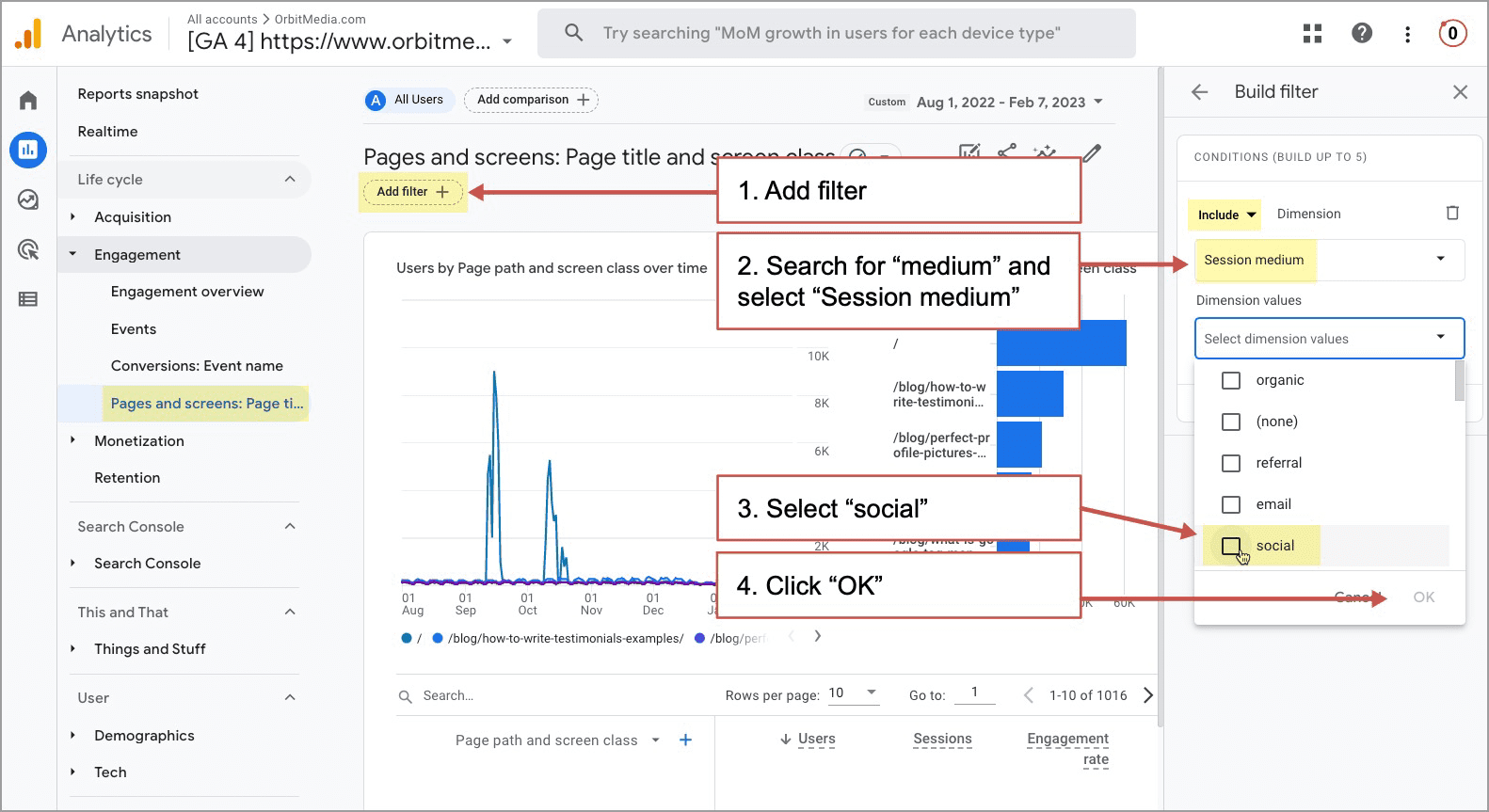
- Type “blog” into the search box to see just the URLs from that directory.
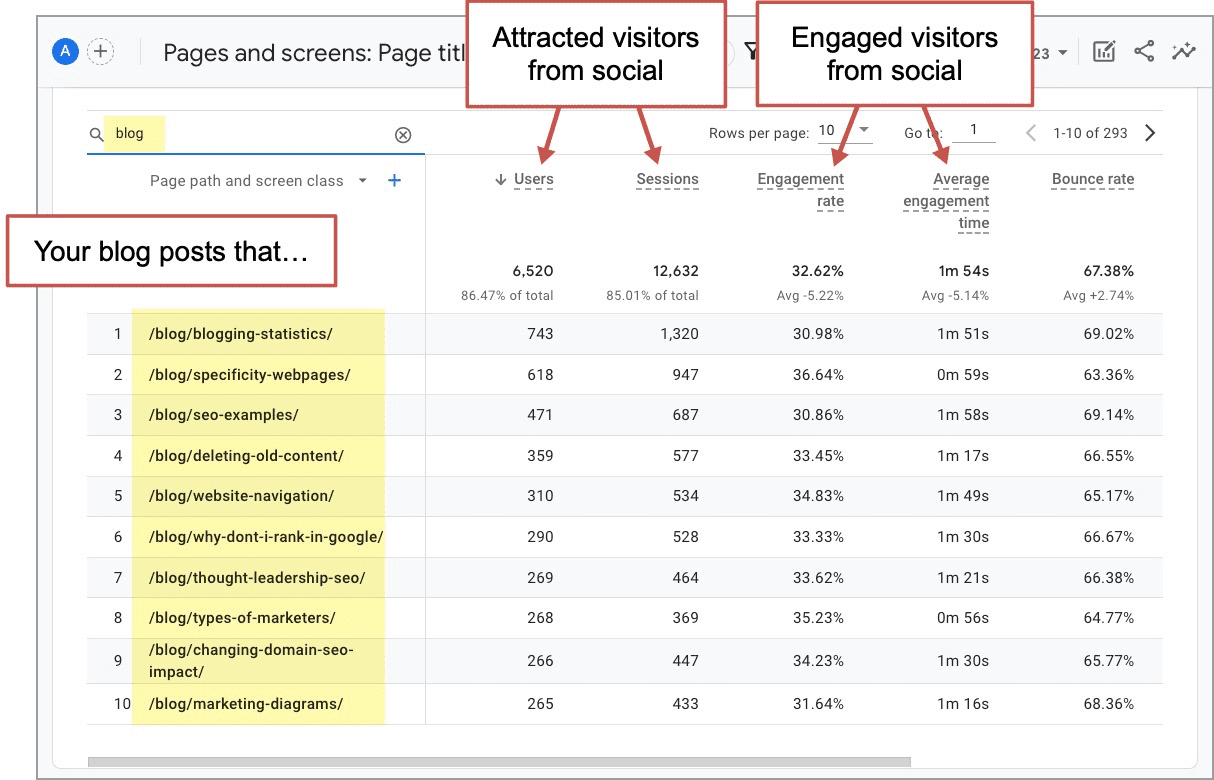
Some of these articles did much better in social media than others. It’s immediately clear that articles with lots of visuals did the best in social media.
Next steps/Action items:
Analyze the top performers, looking closely at the headlines, formatting and visuals. What do they have in common?
- Produce more content with these same attributes for social media promotion
- For the articles with the highest engagement levels, keep them in heavy social rotation
9. Where did this article perform best?
To see the traction any article gets from every traffic source, you don’t need to use a filter. We don’t want to exclude anything. We want to see ALL of the traffic sources for a given URL.
- Go to the Engagement > Pages and Screens report
- Set the primary dimension to “Page path and screen class”
- Search for the article
- Click the blue plus sign (+) to add a second dimension, select “Session source/medium”

Now you’re looking at all of the traffic from all traffic sources to that article. You can see how the article attracted various amounts of traffic with various levels of engagement.
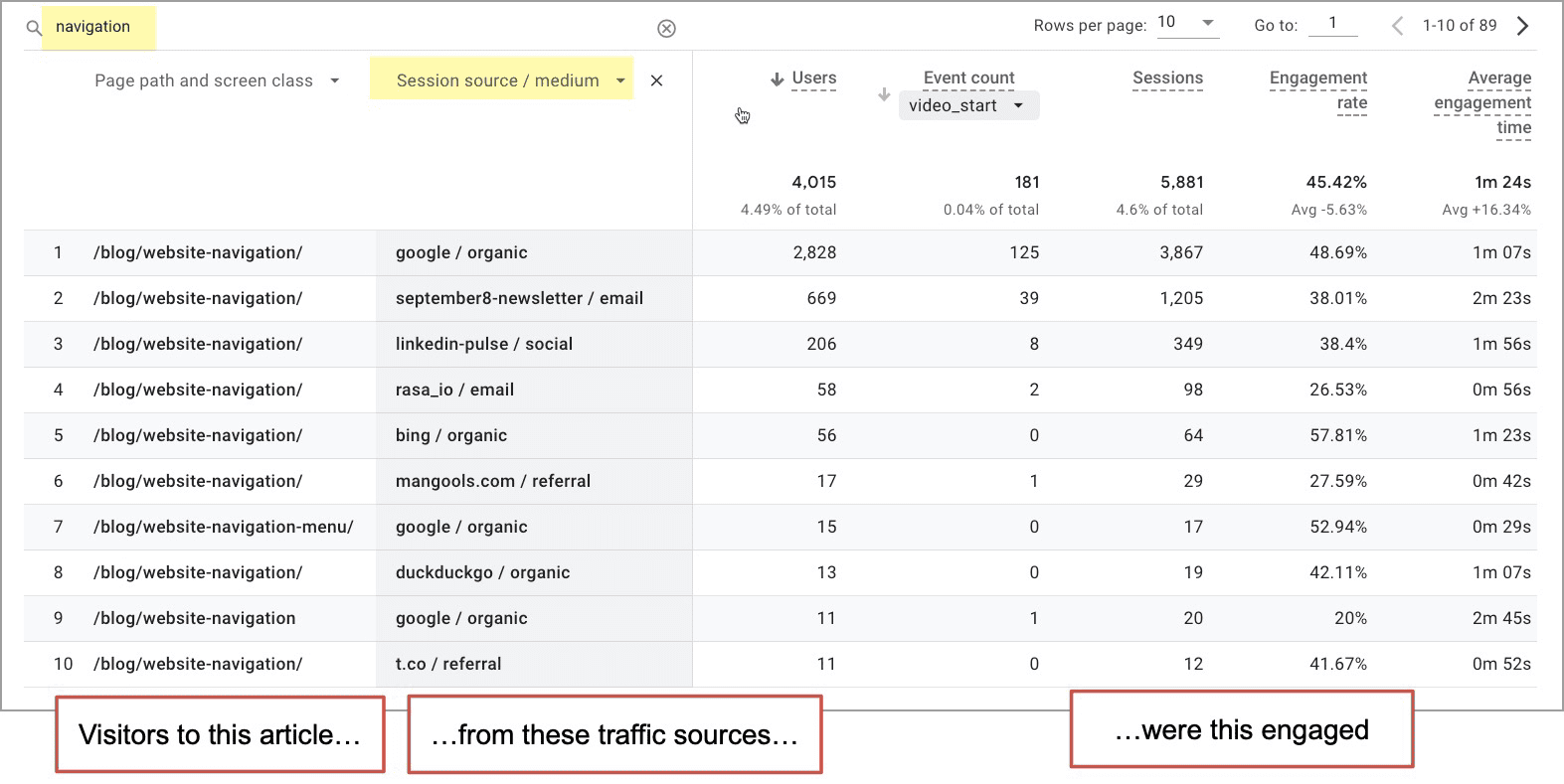
Because this is an article with an embedded video, I’ve added the “Event count” metric to this report and selected the “video_start” event, which is pre-configured for GA4 (no set up required). That gives me the ability to answer this follow up question:
Q: Which source of traffic attracts visitors who were most likely to watch the embedded video?
A: Email (5.4% of visitors from email watch the video, compared to just 3.9% of visitors from LinkedIn)
Next steps/Action items:
This report should trigger content promotion ideas.
- If total traffic from an email or social source was unexpectedly low, re-promote it
- Keep promoting the article in any channel where engagement was above average
If you need a few ideas, here’s our list of 76 ways to promote an article.
If you want to do deeper analysis, consider extracting data from Google Analytics into Big Query, Looker Studio (formerly Google Data Studio) or Google Sheets.
More examples of content analysis using GA4
We could add another dozen reports to this content audit. But by now, you may be thinking of your own analysis. And hopefully, you feel a bit more confident in your GA4 skills.
Try answering these questions using Google Analytics:
- Which of your blog readers are more engaged, mobile or desktop?
- Visitors who land on which of your articles are least likely to scroll?
- How are visitors using your site search? What topics are they looking for?
- How much more engaging are articles with embedded videos?
We answered that last question with a free-form exploration. Take a look!
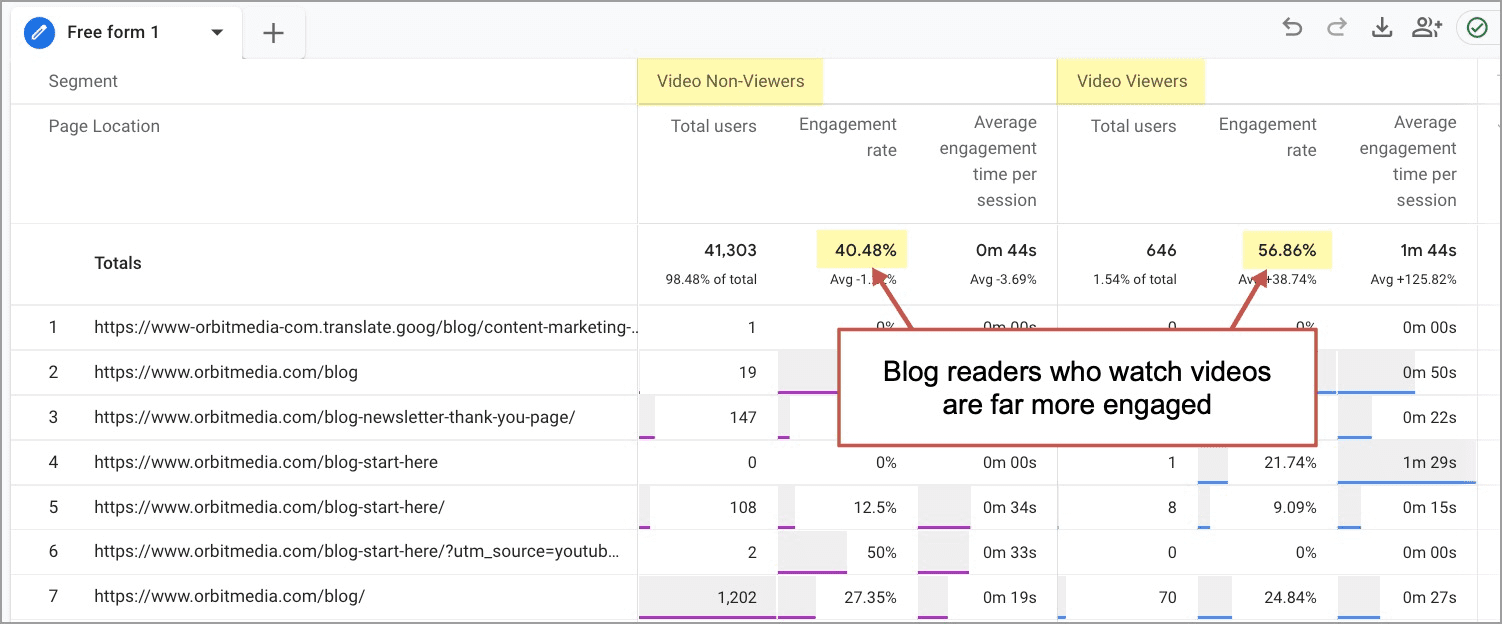
More juice from every squeeze…
That’s the purpose behind this process: to get the greatest potential impact from the smallest possible effort. Since there are so many possible actions we can take in digital marketing, an audit will focus our attention on the actions that matter most.
And we did it all with the basic data stream settings in every GA4 property. No need for custom dimensions or fancy content groupings.
Final step: Repeat
Content marketing, like everything else in digital marketing, is a job that’s never done. But the ongoing work isn’t just publishing and promoting. It’s measuring performance with regular content audits. But how regular? How often? How often should I do a GA4 content marketing audit?
According to the SEMrush State of Content Marketing Report, the majority of content marketers (57%) conduct audits once or twice per year.
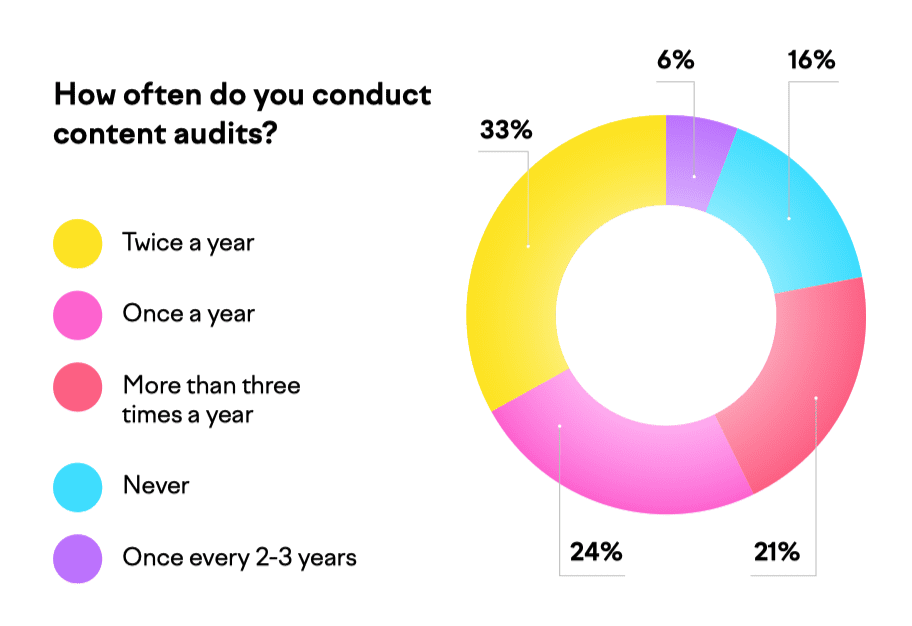
But your search rankings are always in flux. Email campaign results vary widely. User behavior patterns are evolving. Social media performance is constantly changing. That’s why content marketing audits should be conducted quarterly.
[ad_2]
Source link









